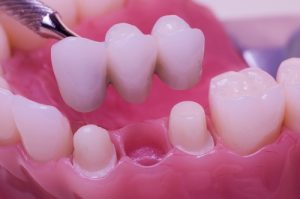 If you’ve lost a couple of teeth to tooth decay or infection, a dental bridge could be an excellent option for tooth replacement. The bridge actually fills the gap between two crowns, whether it’s a one tooth gap or multiple teeth. In preparation for a dental bridge, the teeth on either side of the bridge will need crowns (or caps) placed over them. Once the bridge is placed, the crowns serve as its support. Depending on your situation, you may need implants if your teeth are not strong enough to hold a crown. What is a dental bridge? How does it work?
If you’ve lost a couple of teeth to tooth decay or infection, a dental bridge could be an excellent option for tooth replacement. The bridge actually fills the gap between two crowns, whether it’s a one tooth gap or multiple teeth. In preparation for a dental bridge, the teeth on either side of the bridge will need crowns (or caps) placed over them. Once the bridge is placed, the crowns serve as its support. Depending on your situation, you may need implants if your teeth are not strong enough to hold a crown. What is a dental bridge? How does it work?
What is a Bridge?
A dental bridge serves to restore your lost teeth cosmetically and functionally. Without your teeth, your face could lose its form, your remaining teeth could start to shift to fill the gap, and you won’t be able to chew properly. A dental bridge can fix or prevent all of these issues while also providing cosmetic appeal as they look like normal teeth.
How Do You Install A Dental Bridge?
Parts of the tooth enamel is removed from the surrounding teeth to prepare them for their dental crowns. Impressions need to be made prior to installment of the crowns or the bridge, so your dentist will provide you with temporary crowns and a temporary bridge to protect your exposed teeth while they are making the permanent ones from your impressions. After they are made, you’ll visit your dentist again to ensure the bridge is a proper fit.
What Should I Expect?
Once your bridge is properly installed, you should stick with soft foods until you get used to eating with it. You should practice good oral hygiene – brushing and flossing twice per day – because your surrounding teeth need to be healthy to be able to support your bridge. It’s not uncommon, if you have good oral hygiene, for your bridge to last around 10 years.




Recent Comments